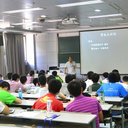Fluoride-elicited developmental testicular toxicity in rats: roles of endoplasmic reticulum stress and inflammatory response.
キーワード
概要
Long-term excessive fluoride intake is known to be toxic and can damage a variety of organs and tissues in the human body. However, the molecular mechanisms underlying fluoride-induced male reproductive toxicity are not well understood. In this study, we used a rat model to simulate the situations of human exposure and aimed to evaluate the roles of endoplasmic reticulum (ER) stress and inflammatory response in fluoride-induced testicular injury. Sprague-Dawley rats were administered with sodium fluoride (NaF) at 25, 50 and 100mg/L via drinking water from pre-pregnancy to gestation, birth and finally to post-puberty. And then the testes of male offspring were studied at 8weeks of age. Our results demonstrated that fluoride treatment increased MDA accumulation, decreased SOD activity, and enhanced germ cell apoptosis. In addition, fluoride elevated mRNA and protein levels of glucose-regulated protein 78 (GRP78), inositol requiring ER-to-nucleus signal kinase 1 (IRE1), and C/EBP homologous protein (CHOP), indicating activation of ER stress signaling. Furthermore, fluoride also induced testicular inflammation, as manifested by gene up-regulation of tumor necrosis factor-α (TNF-α), interleukin-1β (IL-1β), inducible nitric oxide synthase (iNOS) and cyclooxygenase-2 (COX-2), in a nuclear factor-κB (NF-κB)-dependent manner. These were associated with marked histopathological lesions including injury of spermatogonia, decrease of spermatocytes and absence of elongated spermatids, as well as severe ultrastructural abnormalities in testes. Taken together, our results provide compelling evidence that ER stress and inflammation would be novel and significant mechanisms responsible for fluoride-induced disturbance of spermatogenesis and germ cell loss in addition to oxidative stress.






